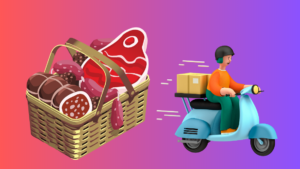In the digital age, the demand for fresh meat delivered directly to customers’ doorsteps has surged significantly. That’s why a lot of entrepreneurs are looking for a successful meat delivery app development.
While app development, user experience, and marketing play key roles in a meat delivery business, logistics is the backbone that ensures the operation runs smoothly and successfully. From sourcing to storage to delivery, efficient logistics can make or break a meat delivery app’s reputation and profitability.
In this blog, we’ll dive deep into how logistics contributes to a successful meat delivery app development and why it should be a top priority for anyone entering the meat delivery space.
The Role of Logistics in Successful Meat Delivery App Development
1. Cold Chain Management: Preserving Freshness
One of the most critical aspects of meat logistics is maintaining the cold chain. Fresh meat is highly perishable, and any deviation from optimal storage temperatures can lead to spoilage or health risks.
Key Components:
- Temperature-Controlled Storage: Warehouses and delivery vehicles should be equipped with refrigeration units.
- Real-Time Monitoring: IoT-based sensors to monitor and record temperatures at every stage.
- Quick Turnaround: Reducing the time from sourcing to delivery helps in preserving freshness.
Why It Matters:
A reliable cold chain builds customer trust and meets food safety regulations, ensuring meat is delivered in peak condition.
2. Inventory & Order Management
Efficient logistics involve robust inventory tracking systems and order management protocols.
Must-Have Features:
- Live Inventory Updates: Avoids overselling or stockouts.
- Batch Tracking: Ensures FIFO (First In First Out) rotation for freshness.
- Smart Reordering: Predictive restocking based on demand patterns.
Benefits:
Proper inventory control reduces waste, maximizes sales, and ensures the availability of popular cuts or items.
3. Last-Mile Delivery Optimization
The last mile is often the most expensive and complex part of the delivery journey. In a successful meat delivery app development, it’s also the most sensitive due to time and temperature constraints.
Best Practices:
- Real-Time Driver Tracking: Helps customers stay updated and builds transparency.
- Route Optimization Algorithms: Ensures the fastest, most fuel-efficient paths.
- Time Slot Deliveries: Allows customers to choose preferred delivery windows, reducing missed deliveries.
Impact:
Well-planned last-mile logistics lead to higher customer satisfaction, lower operational costs, and faster deliveries.

4. Partnering with Local Butchers & Suppliers
Strong logistics help streamline sourcing from local meat suppliers or butcher shops, allowing for:
- Fresher Meat Options
- Faster Fulfillment
- Supporting Local Businesses
By integrating suppliers directly into your logistics network, your meat delivery app script can offer same-day delivery and customized orders.
5. Real-Time Data & Analytics
Logistics systems that generate real-time insights are key to continuous improvement.
What to Track:
- Delivery times and delays
- Customer feedback on delivery quality
- Spoilage and return rates
Outcome:
Data-driven logistics decisions can help you forecast demand, plan inventory, and optimize routes, ultimately improving profit margins.
6. Customer Communication and Transparency
Clear communication around order status, expected delivery time, and any delays improves customer experience.
Logistics integration with the app can enable:
- Live order tracking
- Automated status updates
- Delivery partner contact options
7. Regulatory Compliance
Meat delivery apps must adhere to food safety and transportation regulations. Your logistics setup should ensure:
- Proper hygiene standards
- Compliance with local food laws
- Documentation and tracking for every shipment
This not only ensures safety but also avoids legal complications.
Behind Every Successful Meat Delivery App Development Is a Smarter Logistics Plan!
During a successful meat delivery app development process, it’s easy to focus on flashy features and UI design. However, logistics is the silent force that powers everything behind the scenes, from maintaining product quality to ensuring timely deliveries.
Investing in advanced logistics solutions can help you scale, satisfy customers, and stand out in a competitive market. Whether you’re planning to build a meat delivery app from scratch or optimizing an existing app, prioritizing logistics is essential to delivering not just meat, but excellence.
